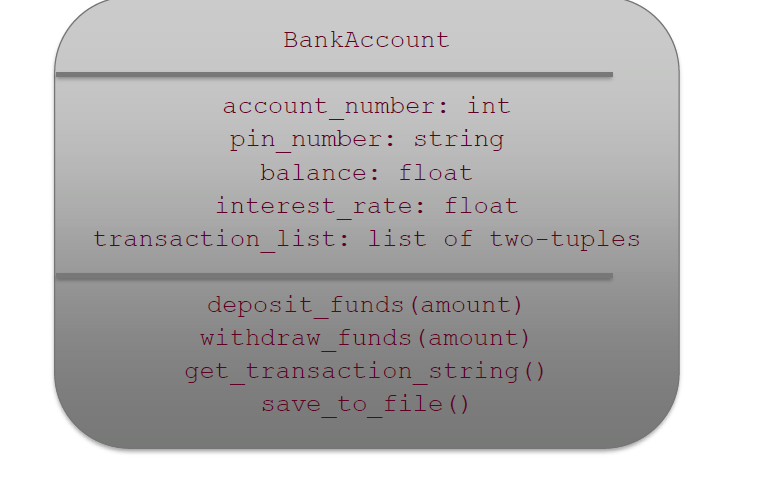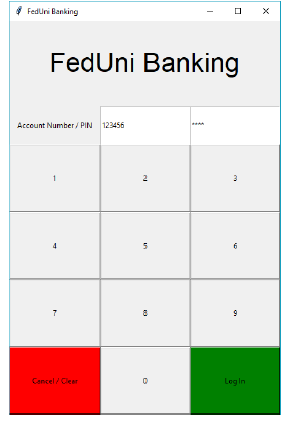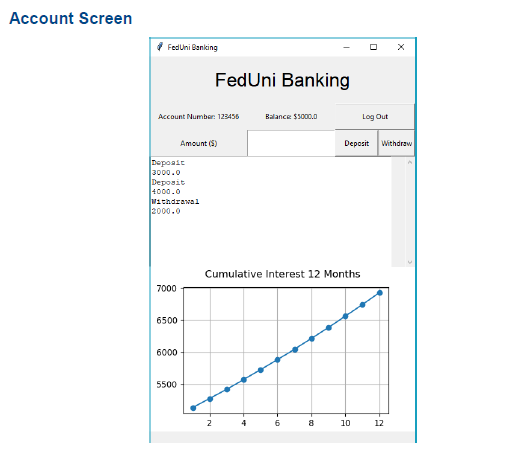Question
home / study / engineering / computer science / computer science questions and answers / implement code in pyhton3 assignment overview you are tasked with
home / study / engineering / computer science / computer science questions and answers / implement code in pyhton3 assignment overview you are tasked with creating an application that ...
Question: Implement Code In Pyhton3 Assignment Overview You are tasked with creating an application that us...
Implement Code In Pyhton3
Assignment Overview You are tasked with creating an application that uses a GUI that simulates a simple banking interface similar to an ATM / online banking using the Python 3 programming language. The assignment is broken up into five main components: 1.) The ability to provide an account number and a PIN (Personal Identification Number) to sign into a bank account, 2.) The ability to view the balance of the bank account and to deposit and withdraw virtual money into and out from the account, 3.) The ability to save transactions via file storage so that you can log in, deposit some money and then log out and when you log back in that money is still there, and finally 4.) The ability to display a graph of projected earnings on the bank account via the compound interest accrued over a variable amount of time. 5.) A Test Case that ensures your BankAccount's deposit and withdraw functionality operates correctly. Your submission should consist of three Python scripts that implement this application as described in the following pages: bankaccount.py, main.py along with a testbankaccount.py which contains a small test case with a few simple unit tests than ensure that your bank accounts deposit_funds and withdraw_funds methods operate correctly. You are provided with a 'stub' of each of these files which contain all the function declarations and comments which describe the role of the function and how it can be put together, but you will have to write the code for vast majority of the functions yourself. You are also provided with a stub of the bankaccounttestcase.py file. Your final submission should be a zipped archive (i.e. zip file) containing your completed Python scripts. There is no word processed component to this second assignment.
Bank Account Class Design

As you might imagine, the deposit_funds(amount) function adds that money to the current balance of the account, and the withdraw_funds(amount) function removes (i.e. subtracts) money from the current balance of the account. Each transaction in the transaction_list is a tuple containing either the word Deposit or the word Withdrawal followed by an amount, for example: ("Deposit", 300.0) or ("Withdrawal", 100.0). The bank accounts in our program do not have an overdraft facility so the user cannot withdraw money they do not have that is, if they had $200 in their account and they tried to withdraw more than $200 then the operation should fail and the withdraw_funds function should raise an Exception with a suitable error message which is caught and displayed in the main.py file where the operation was attempted. All error messages such as those from exceptions should be displayed in a pop-up messagebox. The get_transaction_string method should loop over all the transactions in the transaction_list creating a string version (with newline characters) of all the transactions associated with the account. The save_to_file function should save the account_number, pin_number, balance, and interest_rate in that order to a file called .txt followed by the transaction list string generated from the get_transaction_string() method. The name of the account file is NOT '.txt' - the name of the file is the ACTUAL ACCOUNT NUMBER followed by ".txt", so for an account with account_number 123456 the name of the account file would be 123456.txt. A full walk-through video demonstrating the completed application and how it operates will be provided along with this assignment document.
Calculating Interest To make it worthwhile for you to keep your money with a bank, the bank offers you an interest rate on your savings. Interest will be applied to the balance of an account once per month. Lets do an example suppose you had $10,000 in a bank account and the bank paid you monthly interest at a rate of 3% per year. That would mean the bank pays you 3% of your balance divided by 12 (because there are 12 months in a year) per month. If we start our example on January and run it for a few months (and we dont deposit or withdraw any money throughout the year) then we end up with our bank balance changing like this: Note: 3% divided by 12 is 0.25% per month so well multiply our balance by 1.0025 to get the new balance.  Whats happening here is that the interest is compounding which just means that we get that 0.25% applied not only to our principle balance (i.e. the $10,000 we started with), but it also gets applied to the interest we earnt. Although 3% interest is very low (but in line with the best rates youd get in Australia at the moment because interest rates are very low), over time this compounding makes a serious difference! Because FedUni Bank is the greatest bank of all time, it offers all accounts an interest rate of 33%. The Main Python Script Our main.py script will contain all the main logic for our program. It will allow us to: - Enter an account number via an Entry field by using the keyboard, - Enter a PIN number via an Entry widget (we can use the keyboard OR a series of buttons to enter the PIN), - Once we are logged in we must be able to: o See the balance of our account, o Deposit funds into our account, o Withdraw funds from our account (only up to the amount we have available), o Display a plot of our projected interest over the next 12 months as outlined above, and finally o Log out of our account. Every time a successful deposit or withdrawal is made then a new transaction should be added to the account's transaction list. When we log out then the account file is overwritten with the new account details including our new balance and any transactions if any have been made. The format of the account text file is as follows (each value on separate lines): account_number account_pin balance interest_rate
Whats happening here is that the interest is compounding which just means that we get that 0.25% applied not only to our principle balance (i.e. the $10,000 we started with), but it also gets applied to the interest we earnt. Although 3% interest is very low (but in line with the best rates youd get in Australia at the moment because interest rates are very low), over time this compounding makes a serious difference! Because FedUni Bank is the greatest bank of all time, it offers all accounts an interest rate of 33%. The Main Python Script Our main.py script will contain all the main logic for our program. It will allow us to: - Enter an account number via an Entry field by using the keyboard, - Enter a PIN number via an Entry widget (we can use the keyboard OR a series of buttons to enter the PIN), - Once we are logged in we must be able to: o See the balance of our account, o Deposit funds into our account, o Withdraw funds from our account (only up to the amount we have available), o Display a plot of our projected interest over the next 12 months as outlined above, and finally o Log out of our account. Every time a successful deposit or withdrawal is made then a new transaction should be added to the account's transaction list. When we log out then the account file is overwritten with the new account details including our new balance and any transactions if any have been made. The format of the account text file is as follows (each value on separate lines): account_number account_pin balance interest_rate
For example, account number 123456 with PIN 7890 and a balance of $800 with an interest rate of 33% would look like this: 123456 7890 800.00 0.33 After these first four lines we may have a number of transactions, each of which is specified as two lines. A deposit is indicated by the word Deposit on one line and then the amount on the next like. For example a deposit of $500 would look like this: Deposit 500.00 Similarly, a withdrawal is also specified as two lines first the word Withdrawal and then on the next line the amount, for example a withdrawal of $200 would look like this: Withdrawal 200.00 You are provided with an example bank account file called 12345678.txt this file along with others will be used to mark your assessment, so you should make sure that your final submission can use bank accounts in this format successfully. You are also provided with a video demonstration of the completed assignment along with this document. Your application should match this user interface and function in the same way. Login Screen When the application is first launched, it should open a window that is "440x640" pixels in size (use the window objects geometry function to set this). Set the title of the window to "FedUni Banking" using the top-level window object's winfo_toplevel().title() function. The window uses the GridManager layout manager for placing GUI elements (e.g. 'widgets'), it contains a Label that spans the top of the window saying "FedUni Banking" (font size is 32). On the next line is a label saying "Account Number" and then an Entry widget for the user to type in their account number and an Entry for the PIN number. It then has a series of buttons from 0 through 9, along with a Log In button and a Clear/Cancel button. Each time a number is pressed it is added to a string - for example, if the user pushed the 4 button then the 3 button then the 2 button and then the 1 button then the string should contain the text "4321". By using the show="*" attribute you can 'mask' the input so that anyone looking over your shoulder cannot see the exact pin number, they'll just see "****" instead. When the Clear/Cancel button is pressed, or when a user "logs out" then this PIN string should be reset to an empty string. When the Log In button is pressed then the program should attempt to open the file with the account number followed by ".txt" - so in the example below, because the account number entered was "123456", the program will attempt to open the file "123456.txt".
If that file could not be opened then a messagebox should display a suitable error message such as "Invalid account number - please try again!". You will have to "try/catch" this risky functionality to avoid the program crashing - see the week 7 lecture materials if you need a recap. If the account exists, then a BankAccount object should be created and the fields of the BankAccount object should be set (e.g. account_number, pin_number, balance, interest_rate, and the transaction_list). Because you don't know how many transactions are stored for this bank account, after reading the first four lines you will need to attempt to read two lines and if they exist create a tuple of the transaction (i.e. it's type and amount) and then add it to the BankAccount object's transaction_list - for example you may do the following in a loop: # Try to read a line, break if we've hit the end of the file line = read_line_from_account_file() if not line: break else: # read another line, create a tuple from both lines and append the # tuple to the the BankAccount object's transaction_list


The account screen has: - A large "FedUni Banking" label at the top that spans 5 columns (font size is 24), - A label with the account number followed by the actual account number displayed, - A label with the current balance followed by the actual balance, - A log out button which saves the bank account file (overwriting it) and causes all widgets to be removed from the screen and the log in screen displayed again, - An "Amount" label followed by an amount Entry widget where you can type in how much to deposit or withdraw, - Deposit and Withdraw buttons that deposit or withdraw funds using the BankAccount classes methods to do so, - A Text widget (i.e. multi-line text) that shows all the transactions associated with the account. The height of this widget is 10 lines and the width of the widget is 48 characters. - To the right of the Text widget this is a scrollbar which can be used to scroll the Text widget (it is not really showing in the above screenshot because the Text widget does not have more than 10 lines worth of content), and finally - A small graph of the projected cumulative interest over the next 12 months.
Bank Account Test Case The final thing to do is to add a small test case consisting of five unit tests that ensure that the BankAccount class' deposit_funds and withdraw_funds methods operate correctly. You are provided with a stub of a testbankaccount.py test case that already has the definitions of the five unit tests that you will write and a description of what they are testing. Your job is to write suitable assert statements into each of these unit tests so that they ensure the BankAccount classs' deposit and withdraw functions do operate as they should. You should be able to accomplish each unit test in a maximum of two lines of code per unit test. Two things to remember: 1.) The setUp method is automatically executed before each unit test, so the balance gets reset to 1000.0 before each test, and 2.) If your unit test fails (and the test is correct) then you should modify your code so that it passes the test, not the test so that it matches up with what your code is doing!
main.py
import tkinter as tk from tkinter import messagebox
from pylab import plot, show, xlabel, ylabel from matplotlib.backends.backend_tkagg import FigureCanvasTkAgg from matplotlib.figure import Figure
from bankaccount import BankAccount
win = tk.Tk() # Set window size here to '440x640' pixels # Set window title here to 'FedUni Banking'
# The account number entry and associated variable account_number_var = tk.StringVar() account_number_entry = tk.Entry(win, textvariable=account_number_var) account_number_entry.focus_set()
# The pin number entry and associated variable. # Note: Modify this to 'show' PIN numbers as asterisks (i.e. **** not 1234) pin_number_var = tk.StringVar() account_pin_entry = tk.Entry(win, text='PIN Number', textvariable=pin_number_var)
# The balance label and associated variable balance_var = tk.StringVar() balance_var.set('Balance: $0.00') balance_label = tk.Label(win, textvariable=balance_var)
# The Entry widget to accept a numerical value to deposit or withdraw amount_entry = tk.Entry(win)
# The transaction text widget holds text of the accounts transactions transaction_text_widget = tk.Text(win, height=10, width=48)
# The bank account object we will work with account = BankAccount()
BankAccount account number: int pin number: string balance: float interest rate: float transaction list: list of two-tuples deposit funds (amount) withdraw funds (amount) get transaction string() save to file(Step by Step Solution
There are 3 Steps involved in it
Step: 1

Get Instant Access to Expert-Tailored Solutions
See step-by-step solutions with expert insights and AI powered tools for academic success
Step: 2

Step: 3

Ace Your Homework with AI
Get the answers you need in no time with our AI-driven, step-by-step assistance
Get Started


